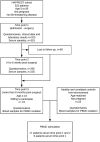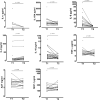An observational study of innate immune responses in patients with acute appendicitis
- PMID: 33060696
- PMCID: PMC7562899
- DOI: 10.1038/s41598-020-73798-3
An observational study of innate immune responses in patients with acute appendicitis
Abstract
Acute appendicitis is a common surgical emergency worldwide. Exaggerated immune responses could be associated with appendicitis. This study aimed at characterizing immune responses towards a large variety of gut commensals and pathogens, and pattern recognition receptor (PRR) ligands, and investigating the course of systemic inflammation in a prospective cohort of acute appendicitis patients. PBMC responses of 23 patients of the cohort and 23 healthy controls were characterized more than 8 months post-surgery. Serum cytokine levels were measured in 23 patients at the time of appendicitis and after one month. CRP, WBC and percentage of neutrophils were analyzed in the total cohort of 325 patients. No differences in PBMC responses were found between patients and controls. Stronger IL-10 responses were found following complicated appendicitis. A trend towards lower IL-8 responses was shown following gangrenous appendicitis. Serum IL-10 and IL-6 were significantly elevated at presentation, and IL-6, IL-8 and TNF-α levels were higher in complicated appendicitis. Routine biomarkers could predict severity of appendicitis with high specificities, but low sensitivities. Cytokine responses in patients following acute appendicitis did not differ from healthy controls. Higher serum cytokine levels were found in acute complicated and gangrenous cases. Further research into discriminative biomarkers is warranted.
Conflict of interest statement
The authors declare no competing interests.
Figures







References
Publication types
MeSH terms
Substances
LinkOut - more resources
Full Text Sources
Medical
Research Materials
Miscellaneous

